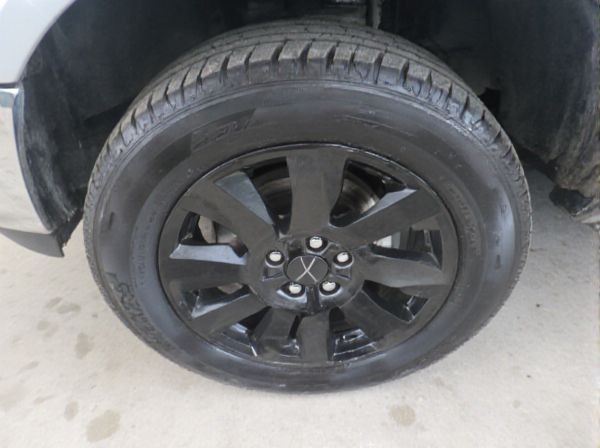
Photo illustration: Directional Vane vs Straight Vane (for cooled wheels)
Directional vanes on cooled wheels improve airflow by guiding the air efficiently towards the wheel surface, enhancing cooling performance and reducing thermal stress. Straight vanes offer simpler manufacturing and maintenance but may provide less optimized airflow, leading to uneven cooling and potential hot spots. Choosing the right vane design impacts your wheel's durability and cooling efficiency, affecting overall braking performance.
Table of Comparison
| Feature | Directional Vane | Straight Vane |
|---|---|---|
| Design | Curved vanes angled for optimized airflow | Straight vanes aligned radially |
| Cooling Efficiency | Higher, due to enhanced air channeling | Moderate, with less focused airflow |
| Noise Level | Lower noise generated from smoother airflow | Higher noise due to turbulent air patterns |
| Durability | Improved vane strength under stress | Standard strength, prone to airflow impact |
| Application | High-performance cooled wheels for sports cars | Everyday vehicles with basic cooling |
| Maintenance | Low, aerodynamic design reduces dirt buildup | Moderate, dirt accumulates between straight vanes |
Introduction to Vanes in Cooled Wheels
Directional vanes in cooled wheels are engineered to enhance airflow management by guiding air with a curved blade design, optimizing cooling efficiency and reducing turbulence. Straight vanes, characterized by their linear, radial blades, prioritize structural simplicity and uniform air distribution but may generate higher aerodynamic resistance. Both vane types influence heat dissipation and aerodynamic balance, making the selection critical for performance in high-speed rotating cooling applications.
What Are Directional Vanes?
Directional vanes on cooled wheels are angled blades designed to channel airflow more efficiently across the brake rotor, enhancing heat dissipation during braking. Unlike straight vanes, which extend radially and promote uniform airflow, directional vanes create a centrifugal force that expels hot air outward, reducing brake fade and improving cooling performance. These vanes are commonly used in high-performance and racing brake rotors where optimal thermal management is critical.
What Are Straight Vanes?
Straight vanes in cooled wheels are aerodynamic blades that extend radially from the hub to the outer rim, designed to improve airflow and heat dissipation during high-speed rotation. Unlike directional vanes, which are angled to guide airflow in a specific path, straight vanes optimize cooling efficiency by creating uniform air circulation, reducing brake temperatures, and enhancing overall wheel performance. Straight vanes are commonly used in performance and racing wheels to maintain brake integrity and prolong component life under intense driving conditions.
Key Differences: Directional vs. Straight Vanes
Directional vanes on cooled wheels are angled to enhance airflow efficiency, directing air precisely to improve heat dissipation and reduce thermal stress, whereas straight vanes provide a simpler, linear airflow path that may be less effective in managing high temperatures. Directional vanes typically generate better cooling performance through optimized aerodynamic flow patterns, making them suitable for high-performance braking systems. Straight vanes, while easier to manufacture and maintain, often result in less effective cooling, potentially leading to quicker brake fade under intense conditions.
Performance Impact on Cooling Efficiency
Directional vanes in cooled wheels enhance airflow by channeling air more effectively across the wheel surface, leading to improved heat dissipation and reduced brake temperatures compared to straight vanes. The aerodynamic design of directional vanes increases cooling efficiency by promoting better ventilation, which helps maintain optimal brake performance during high-stress conditions. In contrast, straight vanes provide a more uniform airflow but generally result in lower cooling rates, making directional vanes the preferred choice for maximizing cooling capabilities in performance applications.
Influence on Wheel Rotation and Airflow
Directional vanes on cooled wheels enhance wheel rotation efficiency by guiding airflow with reduced turbulence, increasing cooling performance and stability during high-speed operation. Straight vanes generate more uniform airflow distribution but create higher drag, leading to increased rotary resistance and reduced wheel speed. Optimizing the vane design directly impacts thermal management and aerodynamic efficiency essential for maintaining wheel integrity and performance in demanding conditions.
Durability and Maintenance Considerations
Directional vanes in cooled wheels offer enhanced durability by promoting better airflow and reducing thermal stress, which minimizes material fatigue compared to straight vanes. Maintenance demands are lower for directional vanes since their optimized design reduces debris buildup and wear, extending service intervals. Straight vanes, while simpler in design, often experience higher rates of corrosion and wear, leading to more frequent inspections and replacements.
Applications and Use Cases
Directional vanes in cooled wheels optimize airflow by guiding air efficiently through the wheel, improving brake cooling performance in high-performance and racing vehicles where heat dissipation is critical. Straight vanes offer simpler, cost-effective airflow management suited for everyday passenger cars and light trucks, providing adequate cooling for standard driving conditions. Racing and heavy-duty vehicles benefit most from directional vanes due to their enhanced thermal regulation, while straight vanes suffice in applications with moderate braking demands.
Pros and Cons: Directional vs. Straight Vanes
Directional vanes in cooled wheels improve airflow efficiency by guiding air through curved paths, reducing turbulence and enhancing cooling performance compared to straight vanes. Straight vanes offer simpler manufacturing and lower cost but generate more turbulence and noise, potentially decreasing overall cooling effectiveness. The choice depends on balancing improved thermal management and aerodynamic efficiency with production complexity and expense.
Choosing the Right Vane Type for Your Application
Directional vanes enhance airflow efficiency by guiding air through cooled wheels with minimal turbulence, making them ideal for high-performance or precision cooling applications. Straight vanes offer a simpler design, provide consistent airflow, and are better suited for general-purpose use where cost-effectiveness and ease of manufacturing are priorities. Selecting the right vane type depends on application-specific requirements such as thermal management needs, airflow characteristics, and system complexity.
 caratoz.com
caratoz.com